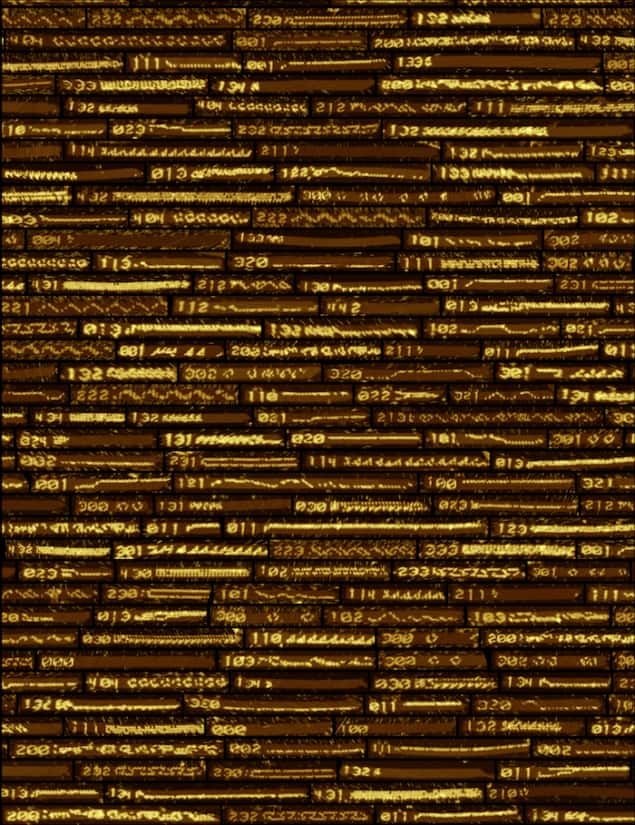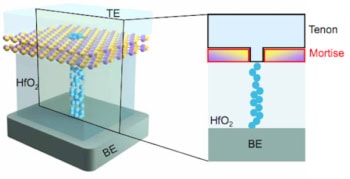
Researchers have designed a tile set of DNA molecules that can carry out robust reprogrammable computations to execute six-bit algorithms and perform a variety of simple tasks. The system, which works thanks to the self-assembly of DNA strands designed to fit together in different ways while executing the algorithm, is an important milestone in constructing a universal DNA-based computing device.
The new system makes use of DNA’s ability to be programmed through the arrangement of its molecules. Each strand of DNA consists of a backbone and four types of molecules known as nucleotide bases – adenine, thymine, cytosine, and guanine (A, T, C, and G) – that can be arranged in any order. This order represents information that can be used by biological cells or, as in this case, by artificially engineered DNA molecules. The A, T, C, and G have a natural tendency to pair up with their counterparts: A base pairs with T, and C pairs with G. And a sequence of bases pairs up with a complementary sequence: ATTAGCA pairs up with TGCTAAT (in the reverse orientation), for example.
The DNA tile
An essential building block in DNA nanotechnology for programmable self-assembly is the DNA tile, which binds through the above Watson-Crick complementary domains to several neighbours arranged on a 1, 2 or 3D lattice. Only a few DNA tile types (each with the same motif but making use of different sequences) are needed to program the self-assembly of large, micron-sized, crystalline structures in which each tile appears periodically.
In this work, the DNA tile set is a collection of short (42 nucleotide) DNA strands designed to fit together into a fabric like a jigsaw puzzle. “Unlike a jigsaw puzzle, however, where each piece fits exactly in one place, our algorithmic tiles can fit together in many different ways depending on the ‘input’,” explains Erik Winfree from the California Institute of Technology (Caltech), who co-led this research study. “The input here is another self-assembled DNA structure, called ‘DNA origami’, which can be designed to carry DNA strands representing any six-bit binary number of choice.”
An arbitrary six-bit Boolean circuit
The input structure in fact acts as a seed for the crystallization of the DNA tiles, forming a DNA nanotube that carries out a computation based on how the tiles fit together, he adds. “Roughly speaking, each new layer of growth on the nanotube represents one more iteration of a six-bit Boolean circuit. We can program the circuit by choosing which strands from a master set are mixed together in a given experiment.
The researchers say they can program a master set of 355 DNA tiles (by selecting the right subset of 100 strands) to compute an arbitrary six-bit circuit. “There are 244 (17 trillion) such circuits possible and although not all of these are interesting, we implemented 21 circuits that display a surprisingly wide range of behaviours,” says Winfree.
“My favourite is an odd little circuit that acts like a clock. It starts with 000010, goes to 011001 and then to 001010. Next, and in a strange order, it goes to 60 other bit patterns before returning to 000010 and repeating the sequence.”
The experiment is limited to six-bit inputs because of certain technical engineering constraints, related to the geometry of the DNA nanotubes, explains study co-lead author David Doty of the University of California, Davis. “With the right DNA tile design though, there’s every reason to think that we could make systems processing far more bits as reliably, or even more so, by amplifying our error-correction techniques in ways we already know.”

As well as the clock, the other circuits the team ran include: a circuit that determines whether a six-bit binary number is a multiple of three; one that determines whether it is a palindrome (that is, reads the same forwards and backwards); one that tests whether the numbers of 1s is even or odd; one that tests for equality with 21 (that is, 010101 in binary); and a circuit that sorts all the 1s to the left and the 0s to the right.
Randomized circuits
The researchers also made some randomized circuits. These occur when molecules are included for more than one function that could be computed at a specific location, explains Winfree. “For example, we considered a molecule that binds to input (0,1) at bit positions 3 and 4, outputting (1,1). If we also include a molecule that binds to (0,1) at bit positions 3 and 4, but presents outputs that encode (0,0), then the computation that occurs depends on which of these two molecules arrives first (which is a random process).
“We can then design such circuits that grow random patterns – such as a single bit that performs a random walk up and down the array of bits.”
Such circuits are important in theoretical computer science, he says.
“Programming at the bench”
All the DNA circuits are made directly in a test tube, which essentially contain billions of completed algorithms, each resembling a knitted scarf of DNA tiles. The pattern on the scarf provides the solution to the algorithm that was run.
“In previous work researchers might have designed a new system and then waited days or even weeks for the DNA stands to be created by a DNA synthesis company and shipped to their lab,” explains study co-lead author Damien Woods, now at Maynooth University in Ireland. Woods performed this study while at Caltech and then at INRIA in France. “We wanted to write programs and then run them immediately. To do this, we designed a set of 355 DNA strands that could implement any program in our six-bit circuit model and then stored these formulations in the fridge.”
Running the circuits is then fairly simple, he tells Physics World. “We write the circuit design in a text file and a computer program converts the circuit description into list of a 100 or so names of our stored DNA strands. We then select these strands and mix them in a test tube with other strands that encode the six-bit input to the circuit. We then read out these circuits by imaging the patterns on them using an atomic force microscope.”

Protocells help make DNA computer
The researchers, reporting their work in Nature, say that if they could reliably scale up their six-bit DNA circuit to much larger numbers, it might be used to make a universal set of DNA tiles that could be reprogrammed to grow any type of structure describable by an algorithm.
“In this scenario, you could, for instance, write a standard computer program that draws a smiley face or flower to the screen,” says Doty. “That program is simply a sequence of bits. If you encode those bits into a seed structure (as our experiment’s seed encoded six bits), the tiles would execute the program and use its output to know exactly where they need to grow to make a smiley face or a flower.”



